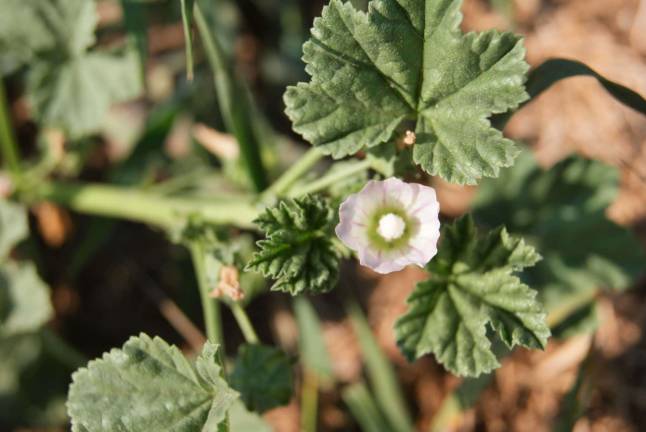A wayside weed with a thousand uses

One of the first signs of life in spring is a magical, overlooked wild plant called mallow that grows in yards and waysides everywhere. Its better known cousins in the Malvaceae family include okra, cotton, cacao and marshmallow – the namesake for the sugar ball, which was originally made using the sap from the plant’s roots.
You can identify mallow rather easily from its geranium-shaped leaves with five or seven lobes. If you have ever seen a hibiscus or rose of Sharon flower, which are in the same family, they look very similar. Mallow is sometimes called cheeseweed, because its fruiting head, with wedge-shaped sections, looks like a tiny wheel of cheese. The “cheese” wheel is actually the plant’s seeds, and you can find them in abundance. Like all parts of this plant, they are edible, and many foragers go after them alone. Fun fact: you can crush mallow and use the juice as a vegetarian rennet to curdle milk and make real cheese. The fruits can also be pickled and used like capers.
Mallow as a medicine is most renowned for its mucilaginous effect, similar to the cooling and lubricating effect of aloe vera. Mucilage sounds like mucous, yes, but don’t fear, this plant chemistry is super healing. Mucilaginous plants can be used as a thickening agent, similar to okra if you cook with a lot of it. This particular thickening agent is made of hundreds of active chemical compounds, whose superstars are now known as mucopolysaccharides. These are complex sugars which are being clinically researched against cancer and have a potent action upon the body.
To get the mucilage from mucilaginous plants, rip up the leaves and soak them overnight. The resultant gel can be added into any kind of soup, food, or herbal remedy. It helps reduce inflammation wherever it goes, soothing conditions like digestive inflammation or constipation, lubricating dried out mucous membranes, or in case of dry hacking cough, lubricating the lungs. Mucilaginous plants are always an expectorant too. This means that when you are coughing, but nothing is coming up, that the body is unable to purge the infection. Adding mucilaginous plants in case of a dry cough will help, especially in combination with an antimicrobial herb.
But you don’t have to turn it into goop to enjoy it. I actually eat mallow leaves whenever I’m in their region, and they are very widespread. When picked young, they can be added to salad and when the leaves get older they make a great addition to any cooked dish. I add them to all of my soups, stews, and sautees, and really love their nutty flavor, and the fact that they are free doesn’t hurt.
Dan de Lion